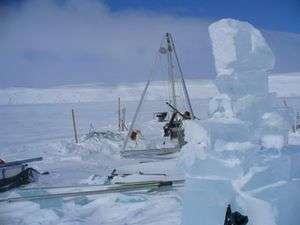Arctic Impact Crater Lake Reveals Interglacial Cycles in Sediments

A University of Arkansas researcher and a team of international scientists have taken cores from the sediments of a Canadian Arctic lake and found an interglacial record indicating two ice-free periods that could pre-date the Holocene Epoch.
Sonja Hausmann, assistant professor of geosciences in the J. William Fulbright College of Arts and Sciences at the University of Arkansas, and her colleagues will report their preliminary findings at the American Geophysical Union meeting this week.
The researchers traveled by increasingly smaller planes, Ski-doos and finally sleds dragged on foot to arrive at the Pingualuit Crater, located in the Parc National des Pingualuit in northern Quebec. The crater formed about 1.4 million years ago as the result of a meteorite impact, and today it hosts a lake about 267 meters deep. Its unique setting - the lake has no surface connection to other surrounding water bodies - makes it a prime candidate for the study of lake sediments.
Scientists study lake sediments to determine environmental information beyond historical records. Hausmann studies diatoms, unicellular algae with shells of silica, which remain in the sediments. Diatoms make excellent bioindicators, Hausmann said, because the diatom community composition changes with environmental changes in acidity, climate, nutrient availability and lake circulation.
By examining relationships between modern diatom communities and their environment, Hausmann and her colleagues can reconstruct various historic environmental changes quantitatively.
However, most sediments of lakes in previously glaciated areas have limitations - they only date back to the last ice age.
"Glaciers are powerful. They polish everything," Hausmann said. Glaciers typically carve out any sediments in a lake bed, meaning any record before the ice age is swept away.
However, the unique composition of the Pingualuit Crater Lake led Michel A. Bouchard to speculate in 1989 that the sediments beneath its icy exterior might have escaped glacial sculpting. So in May of this year, Hausmann and her colleagues donned parkas, hauled equipment on ski-doos and slogged through sub-zero temperatures for three weeks so they could core sediments and collect data from the lake.
They carefully carved squares of ice out to make a small hole for equipment, then began a series of investigations that included pulling up a core of the topmost 8.5 meters of sediment. An echosounder indicated that the lake bottom may have more than 100 meters of relatively fine-grained sediments altogether. During the time since the expedition, researchers have examined the physical, magnetic and sedimentological properties of the sediment core.
The sediment core contains mostly faintly laminated silts or sandy mud with frequent pebble-size rock fragments, which is typical of deposits found in water bodies covered by an ice sheet. Sandwiched in the middle of the faintly laminated silts and sandy mud, the researchers found two distinct and separate layers containing organically rich material that most likely date back well before the Holocene, representing earlier ice-free periods. The samples they found contain the remains of diatoms and other organic material, suggesting that they represent ice-free conditions and possibly interglacial periods.
"There are no paleolimnological studies of lakes that cover several warm periods in this area," Hausmann said. The terrestrial record will be complementary to marine records or to long ice-core records from Greenland.
The international team of researchers in the field included Guillaume St-Onge; Reinhard Pienitz, principal investigator; Veli-Pekka Salonen of the University of Helsinki, Finland; and Richard Niederreiter, coring expert. Please visit www.cen.ulaval.ca/pingualuit/index.html for more information.
Source: University of Arkansas





















